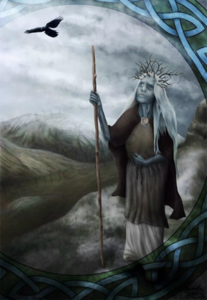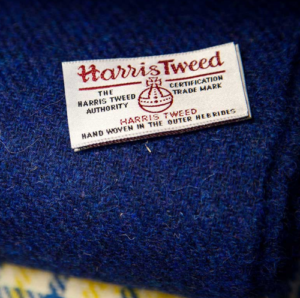Winter’s Myth, Tweed, and Trademark
 In Scottish mythology, Cailleach Bheur (or Beira) is the queen of winter. Beira comes in different flavors. In my favorites, she possesses a single eye capable of seeing beyond duality into the oneness of all beings. She is guardian of the life force, keeping animals during the winter and seeds until spring. She is also the goddess of death and rebirth; things can obviously get complicated from there.
In Scottish mythology, Cailleach Bheur (or Beira) is the queen of winter. Beira comes in different flavors. In my favorites, she possesses a single eye capable of seeing beyond duality into the oneness of all beings. She is guardian of the life force, keeping animals during the winter and seeds until spring. She is also the goddess of death and rebirth; things can obviously get complicated from there.
Maybe less complicated are the weavings of Beira’s subjects—the islanders of The Outer Hebrides. For centuries, they have woven the Clo-Mor cloth (more commonly known as tweed) by hand to weather Beira’s harsh winters. Traditionally, tweed is made from local wool washed in peaty water and colored with dyes from local plants and lichens, then processed and hand-spun by local crofters.
Lady Catherine Hebert of the Isle of Harris commercialized tweed during the industrial revolution. She marketed it as a hard-wearing and water-resistant cloth to landed gentry and aristocracy—including queen Victoria’s inner circle. For over a century Afterwards, Harris Tweed dominated and set the standard for quality. Sherlock Holmes wore it well, as did Mr. Toad and, more recently, The Doctor and Tommy Shelby.
 With Harris Tweed’s success, inexperienced weavers, opportunists, and other gadges began marketing inferior or knock-off tweed.
With Harris Tweed’s success, inexperienced weavers, opportunists, and other gadges began marketing inferior or knock-off tweed.
In the early 1900s, Isle of Harris merchants took action and registered their trademark—the orb—to identify Tweed products that were hand-spun, -woven, and -dyed by outer Hebrides crofters. In 1993 British parliament further strengthened the Harris Tweed trademark with supporting legislation.
Today, every 50 meters of Harris Tweed (still handspun) are checked by a Harris Tweed Inspector before it is stamped by hand with the orb trademark. Harris Tweed is sold under successful brands ranging from Brooks Brothers, Drake’s, and Nike too much smaller, lesser-known companies.
Geamhradh Sona (happy winter).




